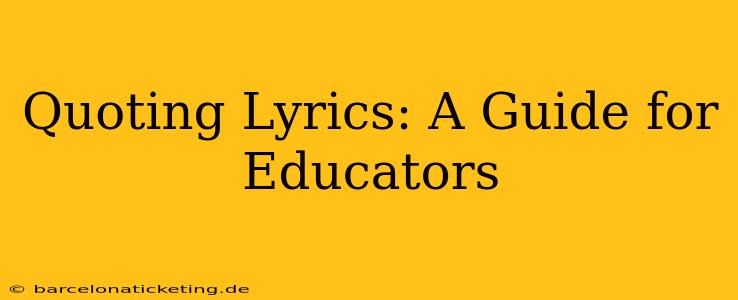Using song lyrics in the classroom can be a powerful tool to engage students, spark critical thinking, and explore various aspects of language, history, and culture. However, it's crucial to do so responsibly and legally. This guide provides educators with practical strategies for integrating lyrics into their lessons while navigating copyright concerns and maximizing pedagogical impact.
Why Use Song Lyrics in the Classroom?
Song lyrics offer a unique blend of poetic language, rhythmic structure, and emotional depth that can resonate with students in ways traditional texts might not. They can be used to:
- Enhance literacy skills: Analyzing lyrics helps students develop skills in interpreting meaning, identifying literary devices (metaphor, simile, personification), and understanding the nuances of language.
- Foster critical thinking: Deconstructing lyrics encourages students to consider the songwriter's message, the social context of the song, and multiple interpretations.
- Explore cultural themes: Music reflects societal values, historical events, and cultural identities, providing a rich source for discussions about diverse perspectives and experiences.
- Boost student engagement: The familiar tunes and relatable themes of popular songs can capture students' attention and motivate their participation.
How to Legally Quote Lyrics in the Classroom
Copyright law protects musical works, including lyrics. While fair use allows for limited quotation in educational settings, it's important to understand its limitations. Generally, fair use considers:
- The purpose and character of your use: Is it for educational purposes, and is it transformative (i.e., adding your own analysis or interpretation)?
- The nature of the copyrighted work: Are you using a well-known song or a lesser-known one?
- The amount and substantiality of the portion used: Using only a few lines or verses is generally acceptable. Using an entire song is not.
- The effect of the use upon the potential market: Your classroom use is unlikely to negatively impact the market for the song.
Best Practices:
- Use short excerpts: Focus on specific lines or verses that directly relate to your lesson objectives.
- Cite your source: Always attribute the lyrics to the songwriter and the song title.
- Limit distribution: Don't create and distribute copies of entire songs or lyric sheets.
- Consider alternatives: If using a large portion of a song is necessary, explore using public domain songs or songs with Creative Commons licenses. Many educational resources offer royalty-free music options.
- Seek permission when necessary: For large-scale projects or performances, it's always best to obtain permission from the copyright holder (often the publishing company).
What are some Creative Ways to Use Lyrics in the Classroom?
H2: How can I use song lyrics to teach different subjects?
Song lyrics can be adapted to various subjects. For instance, historical songs can be used in history classes to illustrate a period's social and political climate. Scientific concepts can be creatively explained through metaphor and analogy found within lyrics. Literature classes can analyze lyrics as poetry, focusing on figurative language and themes.
H2: What are some copyright-friendly strategies for using music in the classroom?
As mentioned, using short excerpts and proper attribution is key. Looking for songs in the public domain, using educational platforms that offer royalty-free music, and focusing on transformative use are all excellent strategies.
H2: How do I assess student understanding of song lyrics in a meaningful way?
Assessments should move beyond simple recall. Encourage students to analyze the lyrics' meaning, identify literary devices, and connect the lyrics to broader themes and concepts relevant to the course. Essays, discussions, presentations, and creative writing assignments based on the lyrical analysis are all viable assessment methods.
H2: How do I choose appropriate songs for my students?
Consider your students' age, maturity level, and cultural background when choosing songs. Select lyrics that align with your lesson objectives and are appropriate for classroom discussion. Be mindful of potentially offensive or inappropriate language or themes. Pre-listening to the song and checking the lyrics for any problematic content is crucial.
By following these guidelines, educators can confidently incorporate song lyrics into their teaching, enhancing the learning experience and promoting a deeper engagement with language and culture. Remember, the key is responsible and thoughtful use, prioritizing both educational value and legal compliance.

